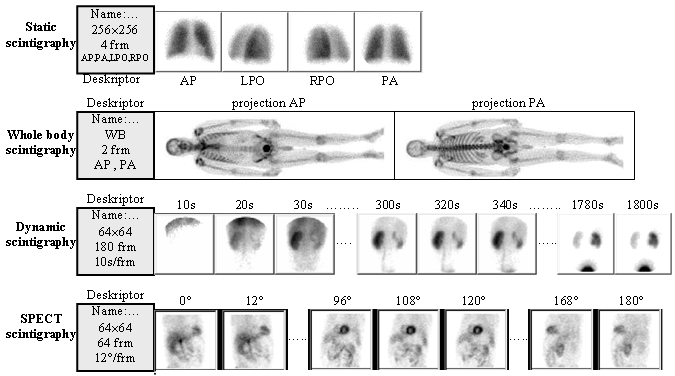
Fig.4.7.1. Structure of individual types of scintigraphic studies recorded in computer memory during acquisition.
| AstroNuclPhysics ® Nuclear Physics - Astrophysics - Cosmology - Philosophy | Physics and nuclear medicine |
4.7.
Mathematical analysis and computer evaluation in nuclear medicine
Computer
technology in scintigraphy
Computer evaluation
of scintigraphic studies
Filters and
filtration
Evaluation by
complex programs
Computer technology in scintigraphy
Scintigraphic data from the camera according to Fig..4.2.3-4 in digital form (using an ADC or directly from a digital camera), they are stored through an acquisition program into memory of evaluation computer and write to the disk drive unit - there scintigraphic studiy containing the descriptor (in which stored relevant information about the patient and examiánation) and further their own accumulated images are creted - Fig.4.7.7 :

Fig.4.7.1. Structure of individual types of scintigraphic studies
recorded in computer memory during acquisition.
The simplest type of scintigraphic study is static or multistatic scintigraphy, which in addition to the descriptor (in which, in addition to administrative data, the number of images, matrix size, orientation, etc., is recorded) contains one or a few scintigraphic images of selected places in the organism, or in various projections. An example is static scintigraphy of the lungs or kidneys, which usually results in 4 images in AP, PA, LR, RR projections. Static images are usually evaluated visually (with appropriately set brightness and contrast), sometimes the ratios of accumulated activity in individual structures marked as areas of interest are quantified.
Another type of static scintigraphy is whole-body scintigraphy, in which a scintigraphic image of the whole body gradually accumulates in a rectangular image matrix during the "sliding" movement of the patient in the longitudinal axis relative to the camera. It is mainly used for skeletal scintigraphy, it is performed in front and rear projection. Whole-body images are evaluated visually, with appropriately set brightness and contrast.
In dynamic scintigraphy, a series of images of a given examination site is sequentially stored at preset time intervals. The descriptor of the dynamic study contains (in addition to administrative data on the patient) the number of images, the time of image storage resp. frame rate, matrix size, orientation, etc. Sometimes "multidynamic" scintigraphy is performed, consisting of several groups of images of different frame rates. A typical example is dynamic scintigraphy of the kidneys or liver. Dynamic scintigraphy is evaluated both visually (sequence of suitably summed images with set brightness and contrast), mostly quantitatively -from the relevant structures marked as areas of interest, curves of the time course of the radio indicator distribution are created, the mathematical analysis of which calculates important quantitative parameters characterizing the function of the examined organs.
SPECT tomographic
scintigraphy provides a scintigraphic study in
computer memory of a similar structure to dynamic scintigraphy,
but the individual images differ not in time but in scanning
angle. Most often it is about 32 or 64 images including
angles 0-360°, or. 0-180° etc. The angular range and step are
recorded in the descriptor. Computer reconstruction
of such a series of images creates a system of images of cross-sections,
which are, after appropriate graphic adjustments (reorientations,
shifts, sections, etc.), visually evaluated on
the computer screen, sometimes compared with normalized sets,
etc. In the field of cardiology, gated SPECT myocardial
scintigraphy (gated SPECT, 4DM SPECT) is also used.
...............
Transfers
and archiving of scintigraphic examinations - DICOM, PACS.
Scintigraphic studies are recorded in the memory of acquisition
computers in various formats depending on the
type of equipment and the manufacturer. As a result,
scintigraphic data from different systems are usually incompatible
with each other - they cannot be directly transferred and
evaluated between different types of devices. To overcome this
disadvantage, software tools have been developed for transforming
scintigraphic, X-ray and NMRI data into a single format,
enabling their compatible sharing by different evaluation
devices. The first standardized format for scintigraphic data
transmission was INTERFILE.
Currently the most frequently used common standardized
format, into which the data from individual systems
transformed, is DICOM (Digital Imaging
and COmmunication in Medicine).
This standardized system provides communication and collaboration
between devices, acquired data formats, and modalities, including
fusion of images from different modalities.
The PACS (Picture Archiving
and Communication System) is
used to storage of image data. It enables the transmission and
archiving of complete image data in DICOM format from
scintigraphy (planar, SPECT, PET), X-ray images (planar or CT)
and nuclear magnetic resonance images. It is stored in the
database system on large-capacity computer storage.
..........................
Computer evaluation of
scintigraphic studies
Mathematical analysis and computer evaluation of scintigraphic
studies is described in detail in a separate book:
" Comprehensive
computer evaluation
of
functional scintigraphic examinations on a PC
-
OSTNUCLINE system "
Filters and filtration
The issue of filtering scintigraphic images is discussed in a
separate work:
" Filters and filtration in nuclear medicine "
Evaluation by complex programs
| Back: Nuclear physics and physics of ionizing radiation | |||
| Nuclear and radiation physics | Radiation detection and spectrometry | Radiation applications | |
| With cintigraphy | Computer evaluation of scintigraphy | Radiation protection | |
| Gravity, black holes and space - time physics Anthropic principle or cosmic God | |||
| AstroNuclPhysics ® Nuclear Physics - Astrophysics - Cosmology - Philosophy | |||
Vojtech Ullmann